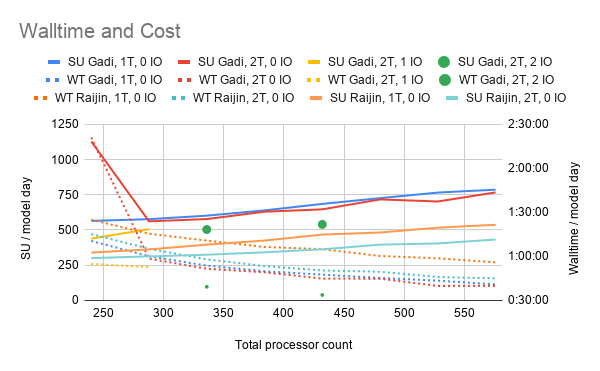Difference between revisions of "WRF performance"
(Created page with "= Configuration = We tested the performance of WRF with the CORDEX domain with a nest over NSW, NARCliM project setup. It is possible to look at WRF performance with other do...") |
|||
| Line 4: | Line 4: | ||
It is possible to look at WRF performance with other domains as long as those are used by a group of people and are used over a significant period of time if possible. Please contact [mailto:cws_help@nci.org.au cws_help@nci.org.au] to discuss the possibility. | It is possible to look at WRF performance with other domains as long as those are used by a group of people and are used over a significant period of time if possible. Please contact [mailto:cws_help@nci.org.au cws_help@nci.org.au] to discuss the possibility. | ||
| − | The configuration tested can be found [ | + | The configuration tested can be found at /g/data/sx70/wrf-scaling. |
| + | |||
| + | = Results = | ||
| + | Below is a chart showing the walltime (WT) and the SU cost per model day for different number of processors, threads and I/O quilting options. | ||
| + | |||
| + | The chart shows the data for Gadi and some for Raijin as a comparison. | ||
| + | |||
| + | In the legend, "T" indicates the number of threads (OpenMP). | ||
| + | |||
| + | One can see for this configuration, the best option is to run with 480 processors, 2 OpenMP threads and 1 I/O group with 2 tasks. This gives the best walltime at one of the lowest cost in SU. Unfortunately, it seems simulations with I/O quilting aren't very stable (this doesn't show in those short tests) so please choose the configuration you think is best for you. | ||
| + | |||
| + | [[File:WRF scaling v4.1.3.png|1000px|center]] | ||
Revision as of 21:14, 17 December 2019
Configuration
We tested the performance of WRF with the CORDEX domain with a nest over NSW, NARCliM project setup.
It is possible to look at WRF performance with other domains as long as those are used by a group of people and are used over a significant period of time if possible. Please contact cws_help@nci.org.au to discuss the possibility.
The configuration tested can be found at /g/data/sx70/wrf-scaling.
Results
Below is a chart showing the walltime (WT) and the SU cost per model day for different number of processors, threads and I/O quilting options.
The chart shows the data for Gadi and some for Raijin as a comparison.
In the legend, "T" indicates the number of threads (OpenMP).
One can see for this configuration, the best option is to run with 480 processors, 2 OpenMP threads and 1 I/O group with 2 tasks. This gives the best walltime at one of the lowest cost in SU. Unfortunately, it seems simulations with I/O quilting aren't very stable (this doesn't show in those short tests) so please choose the configuration you think is best for you.
